Submitted:
12 October 2023
Posted:
12 October 2023
You are already at the latest version
Abstract
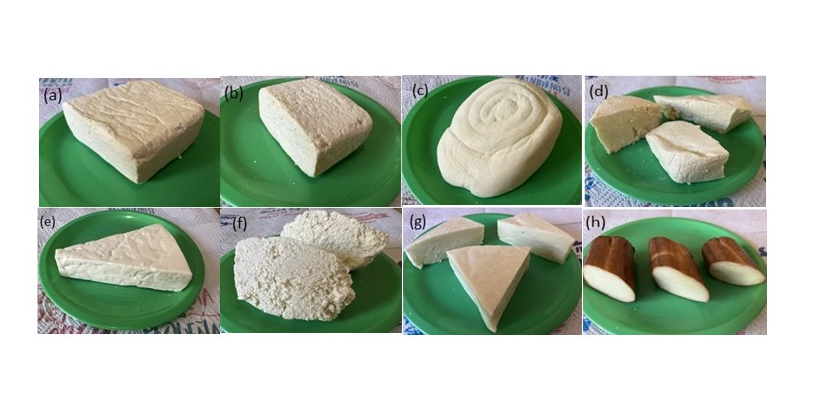
Keywords:
1. Introduction
2. Materials and Methods
2.1. Artisanal cheese samples
2.2. Sample preparation
2.3. Analytical parameters for atomic absorption spectrometry
2.4. Risk analysis
2.4.1. Daily intake of metals
2.4.2. Hazard quotient
2.4.3. Total hazard quotient
2.4.4. Cancer risk and total cancer risk
3. Results and Discussion
3.1. Lead
3.2. Cadmium
3.3. Nickel
3.4. Sources of lead, cadmium, and nickel in artisanal cheeses from Tabasco and Chiapas
- (a)
- Oil industry. Large oil production facilities in Tabasco include Samaria, Jujo, El Golpe, Delta del Grijalva, Bellota, Ogarrio, Cinco Presidentes, and Cuenca de Macuspana, and in Chiapas, Cactus. Southeastern México has 99 oil fields with 935 active wells and 2,360 km of oil ducts connecting wells and oil fields with pumping stations and oil processing centers (Fiedler et al., 2009). Manríquez et al. (2000) determined heavy metals were present in the Mexican crude oils Maya, Istmo, and Olmeca, reporting concentrations between 8 and 277 mg L-1 of vanadium and 2.5 to 52.0 mg L-1 of lead. Siebe et al. (2005) reported the presence of lead (0.01-0.1 mg L-1), chromium (2.0 mg L-1), zinc (0.1-2.5 of 0.2 mg L-1), cadmium (0.02-0.04 mg L-1), and copper (0.2-0.4 mg L-1). In the Cinco Presidentes well in Tabasco, Fridler et al. (2009) analyzed heavy metal concentrations average in ground water reported for Nickel 9 ug L-1, zinc 38 ug L-1, copper 16 ug L-1, cadmium 0.5 ug L-1 and lead 8 ug L-1; in sediments, nickel (49-92 mg kg-1), chromium (73-138 mg kg-1) and lead (8-95 mg kg-1). Villanueva and Botello (2005) determined the content of heavy metals in the sediments of the Laguna el Yucateco in Tabasco and in the muscles of the inhabiting aquatic organisms, reporting between 14.27 and 329.24 µg g-1 of lead, 0.76– 5.52 µg g-1 of cadmium, and 44.61±5.38 µg g-1 of nickel in sediments, and in the muscle of several edible species, 0.33-4.30 mg kg-1 of cadmium, 0.19-15.68 mg kg-1 of lead, and 0.1-8.75 mg kg-1, of nickel —the latter concentrations being above the maximum limits established in the Codex Alimentarius and FAO/WHO (1999). Therefore, the presence of heavy metals is an ecological risk factor because they can move from soils to groundwater, and from there, to aquatic ecosystems where edible species bioaccumulate them.
- (b)
- Agriculture. In the state of Tabasco, nearly 239,904 ha are used for food production using technified agriculture (de la Cruz et al., 2012; Báez et al., 2017; Báez et al., 2018; Hernández, et al., 2018; Murillo et al., 2019; Salgado et al., 2016), and in Chiapas, white maize, sorghum, African palm, bean, cacao, and chilli are sown in nearly 14,000 ha in the municipalities of Catazajá, Palenque, Reforma, and La Libertad (Velázquez y Gómez, 2010; Trinidad et al., 2016; Rojas et al., 2018;). To enhance the yields of crops, large amounts of chemical fertilizers like urea, sulfates, phosphate, and potassium superphosphate are added to the soil, which may be sources of heavy metal pollution. Atafar et al. (2010) found lead (3.32 to 4.28 mg kg-1) and cadmium (0.02-1.12 mg kg-1) in potassium sulphate, ammonium sulfate, and potassium nitrate. Nouri et al. (2008) reported the presence of 0.03 mg kg-1 of cadmium and 1.0 mg kg-1 of copper in urea, and in potassium superphosphate, 12.2 mg kg-1 of cadmium, 60 mg kg-1 of zinc, and 22.5 mg kg-1 of copper. In phosphate fertilizers, Ma et al. (2021) reported the presence of 0.04-65 mg kg-1 of cadmium, 1-20 mg kg-1 of lead, 11-71 mg kg-1 of nickel, 4-130 mg kg-1 of copper, and 6-500 mg kg-1 of zinc.
- (c)
- Urban areas and roads. The large towns and terrestrial communication networks in the regions where artisanal cheese samples were collected are possible sources of heavy metal pollution. Internal combustion engines used in vehicles and the oil industry might emit gasses containing high amounts of heavy metals (de la Cruz et al., 2012). The solid microparticles generated during gasoline and diesel combustion travel long distances dispersing heavy metals and are deposited by gravity on croplands and grazelands (Zhang et al., 2012). Akpoveta and Osakwe (2014) reported contents of 0.24 ppm of lead, 1.68 ppm of cadmium, 1.74 ppm of copper, and 1.43 ppm of zinc in gasolines, and of 1.01 ppm of lead, 1.50 ppm of cadmium, 1.77 ppm of copper, and 2.87 ppm of nickel in diesel.
- (d)
- Processing tools and inputs. The use of metallic utensils and the addition of salt during the manufacturing of artisanal cheeses are possible sources of heavy metal pollution (Elbarbary and Hamouda, 2013; Meshref et al., 2014; Castro et al., 2018; Sidawi et al., 2021).
- (e)
- Volcanic emissions. The eruption of the Chichonal volcano in 1982 emitted large quantities of ashes over Chiapas, Tabasco, Campeche, and southern Veracruz (Tilling, 2009). Rincón et al. (2018) analyzed the sediments from the Chichonal volcano finding 3.26-7.06 mg kg-1 of cadmium, 3.2-4.5 mg kg-1 of lead, 3.2-4.3 mg kg-1 of nickel, 0.83-2.76 mg kg-1 of copper, 3.5-17 mg kg-1 of zinc, and 52-126 mg kg-1 of iron, thus showing that volcanic activity contributed to the distribution of heavy metals on the regions in Tabasco and Chiapas where we collected the samples of artisanal cheeses.
3.5. Copper
3.6. Zinc
3.7. Iron
3.8. Risk analysis
4. Conclusions
Acknowledgments
Conflicts of Interest
References
- Bakircioglu, D.; Kurtulus, Y.B.; Ucar, G. Determination of some traces metal levels in cheese samples packaged in plastic and tin containers by ICP-OES after dry, wet and microwave digestion. Food Chem. Toxicol. 2010, 49, 202–207. [Google Scholar] [CrossRef] [PubMed]
- Benitez, R. A. (2019). Evaluation of microbiological and toxicological quality (heavy metals) in fresh artisan cheese commercialized in Puebla City, Mexico. International Journal of Food Engineering, 5(4), 276-281. [10.18178/ijfe.5.4.
- Bermudez, G.M.; Jasan, R.; Plá, R.; Pignata, M.L. Heavy metal and trace element concentrations in wheat grains: Assessment of potential non-carcinogenic health hazard through their consumption. J. Hazard. Mater. 2011, 193, 264–271. [Google Scholar] [CrossRef] [PubMed]
- Castro, G. N. P. , Calderón, S. F., Perez, S. M., Castro de Jesús, J., Moreno, R. R., Tamariz, F. J., Perez, S. M., Soní, G. E. (2017). Heavy metals in cow´s milk, cheese produced in areas irrigated with waste water in Puebla, Mexico. Food Additives & Contaminants: Part B, 11(1), 33-36. [10.1080/19393210.2017. 1397. [Google Scholar]
- Castro, G. N. P. , Calderón, S. F., Perez, S. M., Soni, G. E., Reyes, C. E. (2019). Health risk due to chronic heavy metal consumption via cow´s milk produced in Puebla, Mexico, in irrigated wastewater areas. Food Additives & Contaminants: Part B, 12(1), 38-44. [10.1080/19393210.2018. 1520. [Google Scholar]
- Castro, G. N. P. , Calderón, S. F., Fuentes de María, T. M. T., Silva, M. S. S. González, J. F. E. (2021). Heavy metals in blood, milk and cow´s urine reared in irrigated areas with waste water. Heliyon, 7, 1-6. [10.1016/j.heliyon.2021.e 06693].
- etinkaya, A. , Akbaba, G. B., Özçakmak, S., Gülbaz, G. (2016). Mineral and heavy metal content in Camİ Boğazi cheese on Sale in Trabzon, Turkey. GIDA The Journal of Food, 41(5), 317-321. [10.15237/gida.GD 16032]. 1603. [Google Scholar]
- Codex Stan Alimentarius. (2015). International Food Standards. World Health Organization, 1-62. www.codexalimentarius.org.
- De la Cruz, P. A. , Zavala, C. J., Guerrero, P. A., Salgado, G. S., Lagunés, E. L. C., Gavi, R. F. (2012). Heavy metals in soils cultivated with sugar cane in the Chontalpa, Tabasco. Journal Universidad y Ciencias,F. ( 28(2), 119-–130.
- EFSA (European Food Safety Authority, 2013). Scientific Opinion on nutrient requirements and dietary intakes of infants and young children in the European Union. EFSA Panel on Dietetic Products, Nutrition and Allergies (NDA). Eur. Food Saf. Auth. (EFSA) Parma Italy EFSA J., 11, 3408. [CrossRef]
- Elbarbary, H.A.; Hamouda, A.F. Variations in some heavy metals’ level during processing of soft cheese. J. Food Meas. Charact. 2013, 7, 194–198. [Google Scholar] [CrossRef]
- European Commission (EC). (2001). Setting maximum levels for certain contaminants in food stuffs. Off. J. Eur. Communities, 77, 1–75. [https://europa.eu/en/publication-detail/-/publication/52b2484d-39e0-4aa9-ba19-4b13a887bb1c]. 2484.
- Environmental Protection Agency; National Air Toxics Assessment (NATA). 2014 NATA: Technical Support Document. 2014. Available online: [https://www.epa.gov/national-air-toxics-assessment/2014-nata-technicalsupport-document]. 2014.
- FAO/WHO. (1999). Joint FAO/WHO foods standards programed. Expert committee on the food additives, summary and conclusions, in: 53rd Meeting, Rome, June1-10. [chrome-extension://efaidnbmnnnibpcajpcglclefindmkaj/http://www.leffingwell.com/Summary%20and%20Conclusions%20of%20the%20Fifty-third%20meeting.pdf].
- Fiedler, S.; Siebe, C.; Herre, A.; Roth, B.; Cram, S.; Stahr, K. Contribution of Oil Industry Activities to Environmental Loads of Heavy Metals in the Tabasco Lowlands, Mexico. Water, Air, Soil Pollut. 2009, 197, 35–47. [Google Scholar] [CrossRef]
- Ghafari, H.R.; Sobhanardakani, S. Contamination and Health Risks from Heavy Metals (Cd and Pb) and Trace Elements (Cu and Zn) in Dairy Products. Iran. J. Heal. Sci. 2017, 5, 49–57. [Google Scholar] [CrossRef]
- González, C. A. F. , Yescas, C., Ortiz, E. A. M., De la Rosa, A. M. A., Hernández, M. A., Vallejo, C. B. (2016). Artisanal Mexican Cheeses. Journal of Dairy Science, 99(5), 3250-3262. [10.3168/jds.2015-10103]. 2015. [Google Scholar]
- Gupta, D. K. , Chatterjee, S., Datta, S., Veer, V., Walther, C. (2014). Role of phosphate fertilizers in heavy metal uptake and detoxication of toxic metals. Chemosphere, 108, 134-144. [10.1016/j.chemosphere.2014.01.030].
- Izah, S.C.; Chakrabarty, N.; Srivastav, A.L. A Review on Heavy Metal Concentration in Potable Water Sources in Nigeria: Human Health Effects and Mitigating Measures. Water Qual. Expo. Heal. 2016, 8, 285–304. [Google Scholar] [CrossRef]
- Jaishankar, M.; Tseten, T.; Anbalagan, N.; Mathew, B.B.; Beeregowda, K.N. Toxicity, mechanism and health effects of some heavy metals. Interdiscip. Toxicol. 2014, 7, 60–72. [Google Scholar] [CrossRef]
- Jalili, M. Chemical composition and sensory characteristics of Feta cheese fortified with iron and ascorbic acid. Dairy Sci. Technol. 2016, 96, 579–589. [Google Scholar] [CrossRef]
- Kirdar. S. S., Ocak, E., Köse, S. (2013). Mineral and trace metal levels of Akcakatic cheese collected form Mediterranean region-Turkey. Asian Journal of Chemistry, 25(3), 1643-1646. [CrossRef]
- Lante, A.; Lomolino, G.; Cagnin, M.; Spettoli, P. Content and characterisation of minerals in milk and in Crescenza and Squacquerone Italian fresh cheeses by ICP-OES. Food Control. 2006, 17, 229–233. [Google Scholar] [CrossRef]
- Manríquez, L. , Moreno, A., Tenorio, R. E., Herrera, D. (2000). Guide to world crudes. Four Mexican crude assays update. Oil & Gas Journal, 15, 54-57.
- Mendil, D. Mineral and trace metal levels in some cheese collected from Turkey. Food Chem. 2006, 96, 532–537. [Google Scholar] [CrossRef]
- Meshref, A.M.S.; Moselhy, W.A.; Hassan, N.E.-H.Y. Heavy metals and trace elements levels in milk and milk products. J. Food Meas. Charact. 2014, 8, 381–388. [Google Scholar] [CrossRef]
- Moreno, R. R. , Sanchez, S. P. J., Cámara, M. F., Amparo, L. M. A. (2010). Heavy metal levels in Spanish cheeses: influence of manufacturing conditions. Food Additives and Contaminants: Part B, 3(2), 90-100. [10.1080/19440049.2010.491838]. 4918. [Google Scholar]
- Naseri, K. , Salmani, F., Zeinali, M., Zeinali, T. (2021). Health risk assessment of Cd, Cr, Cu, Ni and Pb in the muscle, liver and gizzard of hen’s marketed in East of Iran. Toxicology Reports, 8, 53-59. [CrossRef]
- Noël, L.; Chekri, R.; Millour, S.; Vastel, C.; Kadar, A.; Sirot, V.; Leblanc, J.-C.; Guérin, T. Li, Cr, Mn, Co, Ni, Cu, Zn, Se and Mo levels in foodstuffs from the Second French TDS. Food Chem. 2012, 132, 1502–1513. [Google Scholar] [CrossRef] [PubMed]
- Nom-243-ssa1-2020. (2010). Official Mexican Standard. Productos y servicios. Leche, Formula láctea y producto lácteo combinado. Especificaciones sanitarias. [http://dof.gob.mx/nota_detalle_popup.php?codigo=5160755]. 5160.
- OECD/FAO. Agricultural Outlook 2018–2027.
- Olivares, A. V. , Valverde, S. L., Quiroz, R. V., García, R. R, Muñoz, N., Navarro, A. M., Cabrera V. C. (2015). Níquel en alimentos y factores influyentes en sus niveles, ingesta, biodiesponibilidad y toxicidad: una revisión. CyTA-Journal of Food, 13(1), 87-101. [CrossRef]
- Olujimi, O. O. , Abubakar, R., Faburoso, E., Sodiya, C. I., Ojo, O. E., Towolawi, A. T. (2018). Levels of heavy metals in local milk and cheese, and phthalate esters in cheese by settled Fulani pastoralists in Ogun and Oyo States, Nigeria. Nigerian Food Journal, 36(1), 12-20. 0: [eISSN 0189-7241], 0189. [Google Scholar]
- Orak, H. , Altun, M, Ercag, E. Survey of heavy metals in Turkish white cheese. Italian Journal Food Science, 17, 95–100.
- Palma-López, D. J. , Cisneros, D. J., Moreno, C. E., Rincón-Ramírez, J. A. (2007). Suelos de Tabasco: su uso y manejo sustentable. Colegio de Postgraduados-ISPROTAB-Fundacion Produce Tabasco. Villahermosa, Tabasco, México.
- Quintanilla, M. M. , Gold, B. G., Zapata, P. O., Rubio, P. J., Quiroz, M. A., Vidal, M. V., Aguirre, M. M., Puch, H. C. (2020). Biological responses of shoal flounder (Syacium gunteri) to toxic environmental pollutants from the southern Gulf of Mexico. Environmental Pollution, 258, 1-13. [10.1016/j.envpol.2019. 1136. [Google Scholar]
- Reinholds, I.; Rusko, J.; Pugajeva, I.; Berzina, Z.; Jansons, M.; Kirilina-Gutmane, O.; Tihomirova, K.; Bartkevics, V. The Occurrence and Dietary Exposure Assessment of Mycotoxins, Biogenic Amines, and Heavy Metals in Mould-Ripened Blue Cheeses. Foods 2020, 9, 93. [Google Scholar] [CrossRef] [PubMed]
- Rincón, M. C. I. , Hernández, G. J. A., Rincón, R. R., Gutiérrez, M. F. A., Ramírez, V. D. A., González, T.E. (2018). Structure and Diversity of the Bacterial Communities in the Acid and Thermophilic Crater-Lake of the Volcano "El Chichón", Mexico. Geomicrobiology Journal, 36, 1-13. [CrossRef]
- Romero, E. D. , Yañez, J. G. S., Simbaña, F. K., Navarrete, H. (2019). Distribution, contents, and health risk assessment of cadmium, lead, and nickel in bananas produced in Ecuador. Foods, 8 (330), 1-11. [10. 3390. [Google Scholar]
- Salgado, G. S. , Palma, L. D. J, Zavala, C. J., Córdova, S. S., Castelán, E. M. (2016). Sustainable fertilization program for plantations of citrus in Tabasco, Mexico. Journal Ecosistemas y Recursos Agropecuarios 3(9), 345–356.
- Sieba, C. , Cram, S., Herre, A., Fernández B. N. (2005). Distribución de metales pesados en los suelos de la llanura alluvial baja del activo Cinco Presidentes, Tabasco, Mexico. In A. V. Botello, J. Rendón von Osten, G. Gold-Bouchot & C. Agraz-Hernández (Eds.), Golfo de México-Contaminación e Impacto Ambiental, Diagnostico y Tendencias (pp. 385-403). Universidad Autónoma de Campeche-UNAM.
- US-EPA. (2002). United States Environmental Protection Agency. Washington (DC): Supplemental Guidance for Developing Soil Screening Levels for Superfund Sites Office of Solid Waste and Emergency Response. [http://rais.ornl.gov/documents/SSG_nonrad_supplemental.pdf.
- US-EPA-IRIS. Nickel, soluble salts; CASRN Various. Integrated Risk Information System (IRIS) Chemical Assessment Summary, File First On-Line 09/30/1987. Available online: [https://cfpub.epa.gov/ncea/iris/iris_documents/documents/subst/0271_summary.pdf.
- Villanueva, F.S. , Botello, A. V. (2005). Vigilancia y presencia de metales tóxicos en la laguna el Yucateco, Tabasco, México. In: A. V. Botello, J. Rendón-von Osten, G. Gold-Bouchot & C. Agraz-Hernández (Eds.), Golfo de México-Contaminación e Impacto Ambiental, Diagnostico y Tendencias (pp. 407-430). Universidad Autónoma de Campeche-UNAM.
- Yüzbaşı, N.; Sezgin, E.; Yıldırım, M.; Yıldırım, Z. Survey of lead, cadmium, iron, copper and zinc in Kasar cheese. Food Addit. Contam. 2003, 20, 464–469. [Google Scholar] [CrossRef] [PubMed]
- Zafarzadeh, A.; Bonyadi, Z.; Feyzi, K. Health risk assessment related to cadmium in dairy products in Gorgan, Iran. Int. J. Environ. Anal. Chem. 2020, 102, 4058–4066. [Google Scholar] [CrossRef]
- Zhang, F.; Yan, X.; Zeng, C.; Zhang, M.; Shrestha, S.; Devkota, L.P.; Yao, T. Influence of Traffic Activity on Heavy Metal Concentrations of Roadside Farmland Soil in Mountainous Areas. Int. J. Environ. Res. Public Health 2012, 9, 1715–1731. [Google Scholar] [CrossRef] [PubMed]
- Ziarati, P. , Shirkhan, F., Mostafidi, M., Tamaskani, Z. M. (2018). An Overview of the Heavy Metal Contamination in Milk and Dairy Products. Acta Scientific Pharmaceutical Sciences 2(7), 8-21. http://www.inegi.org.mx.
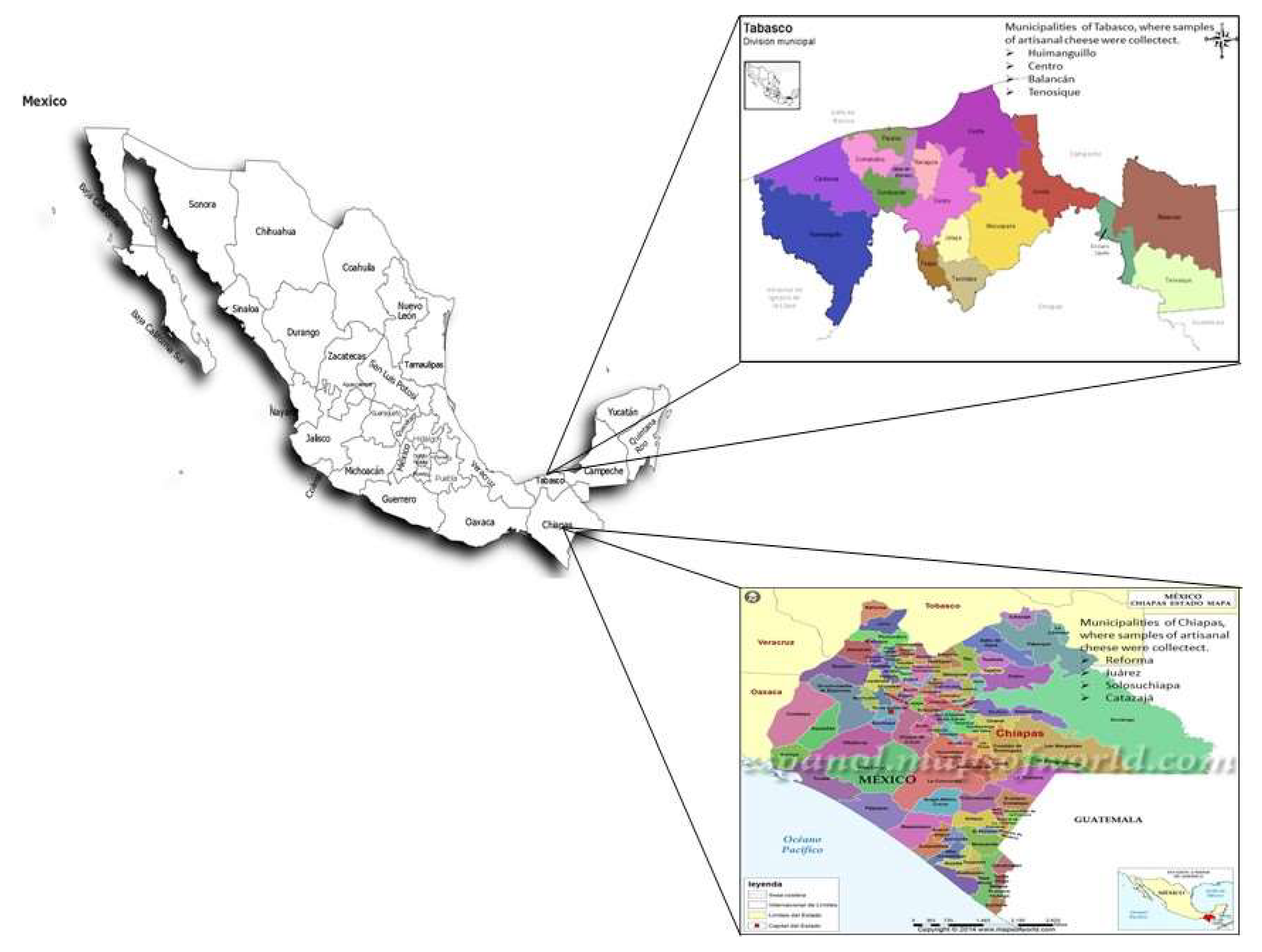
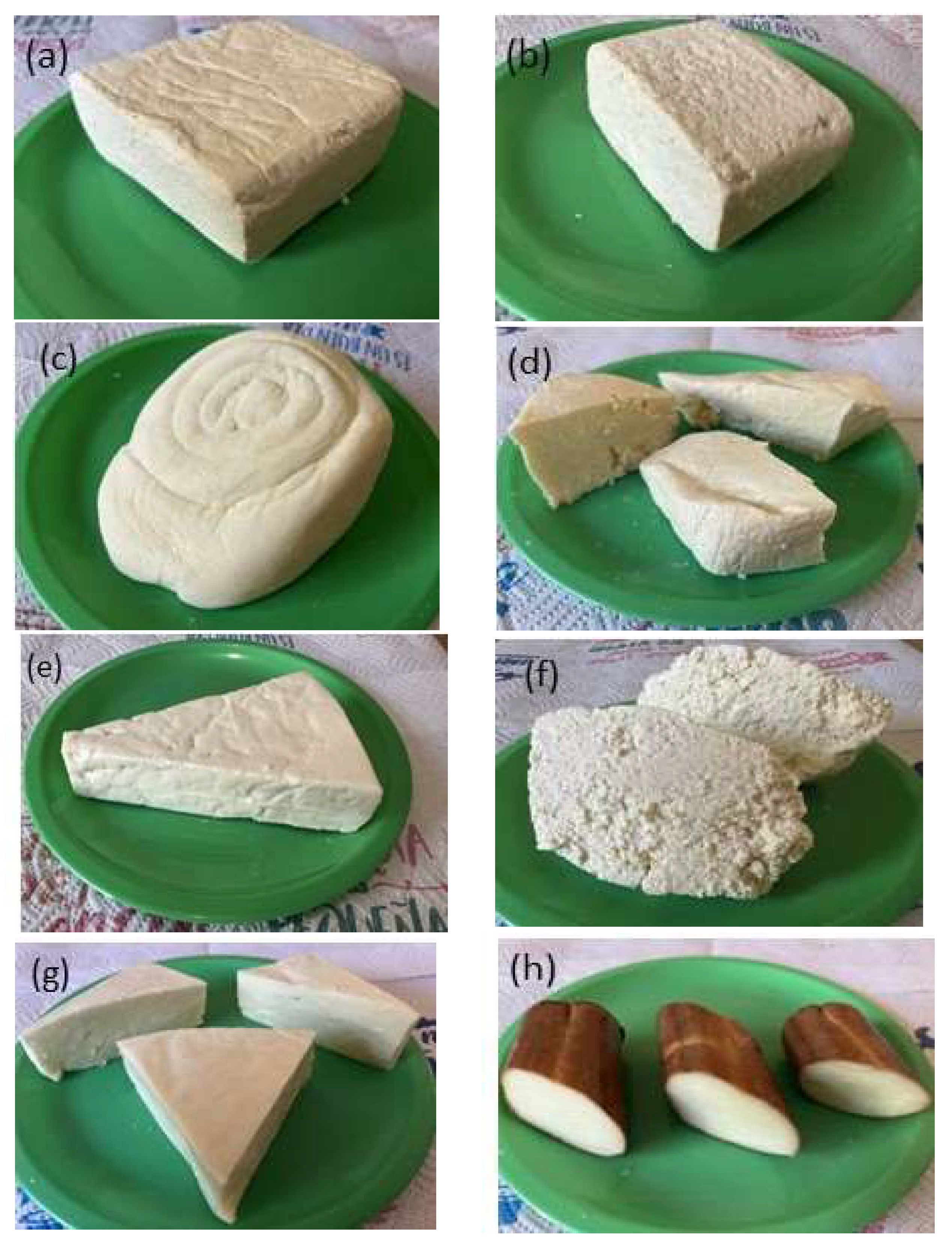

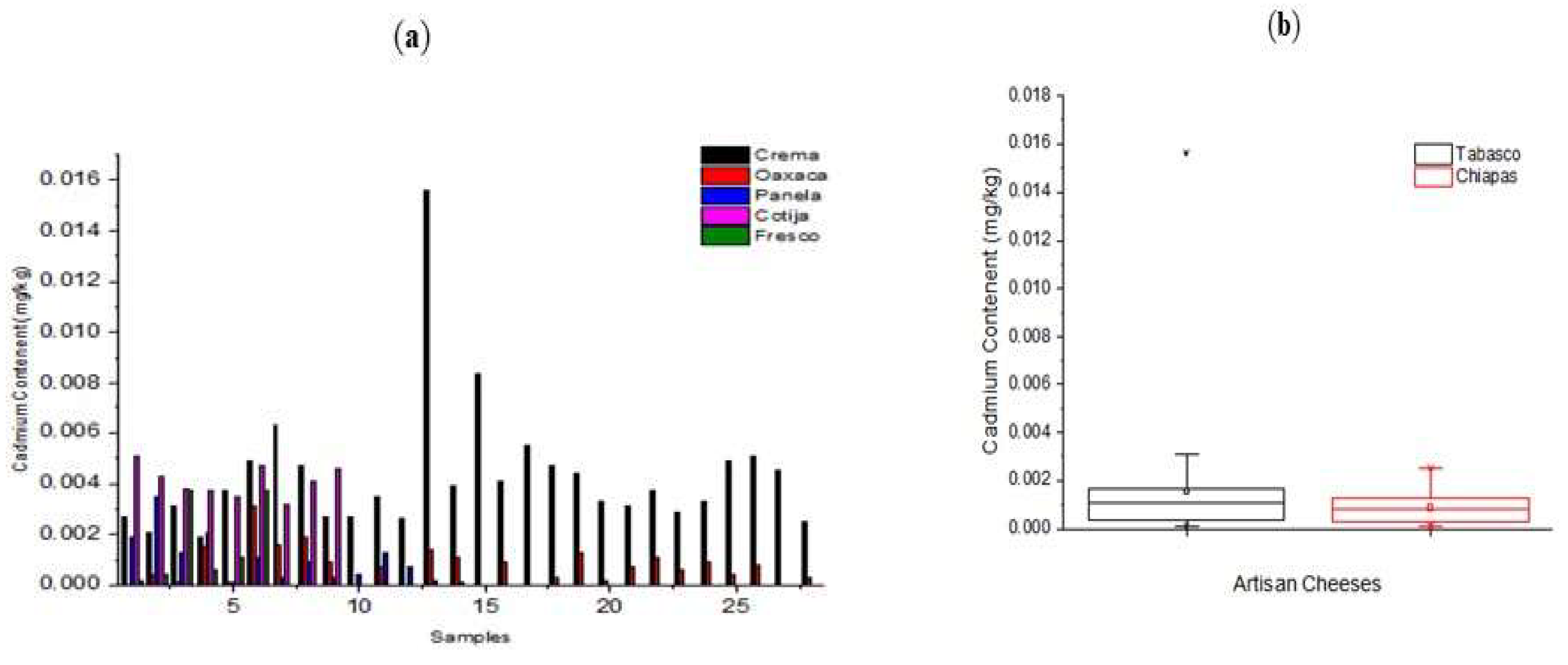

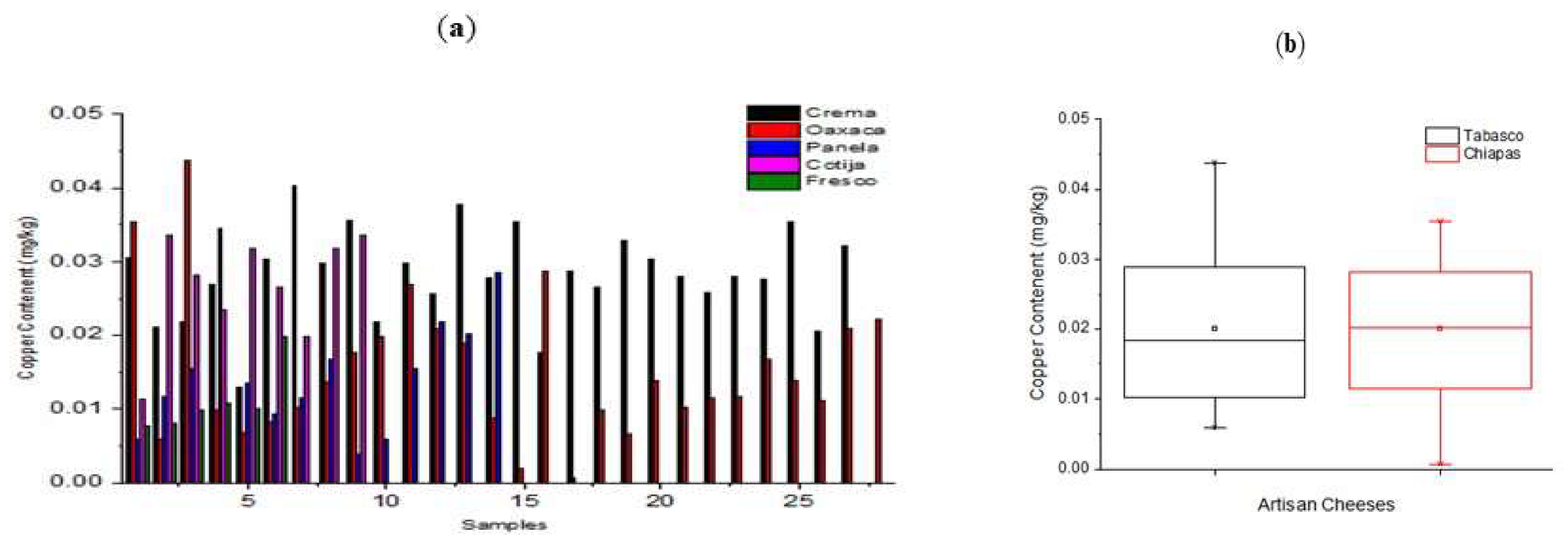
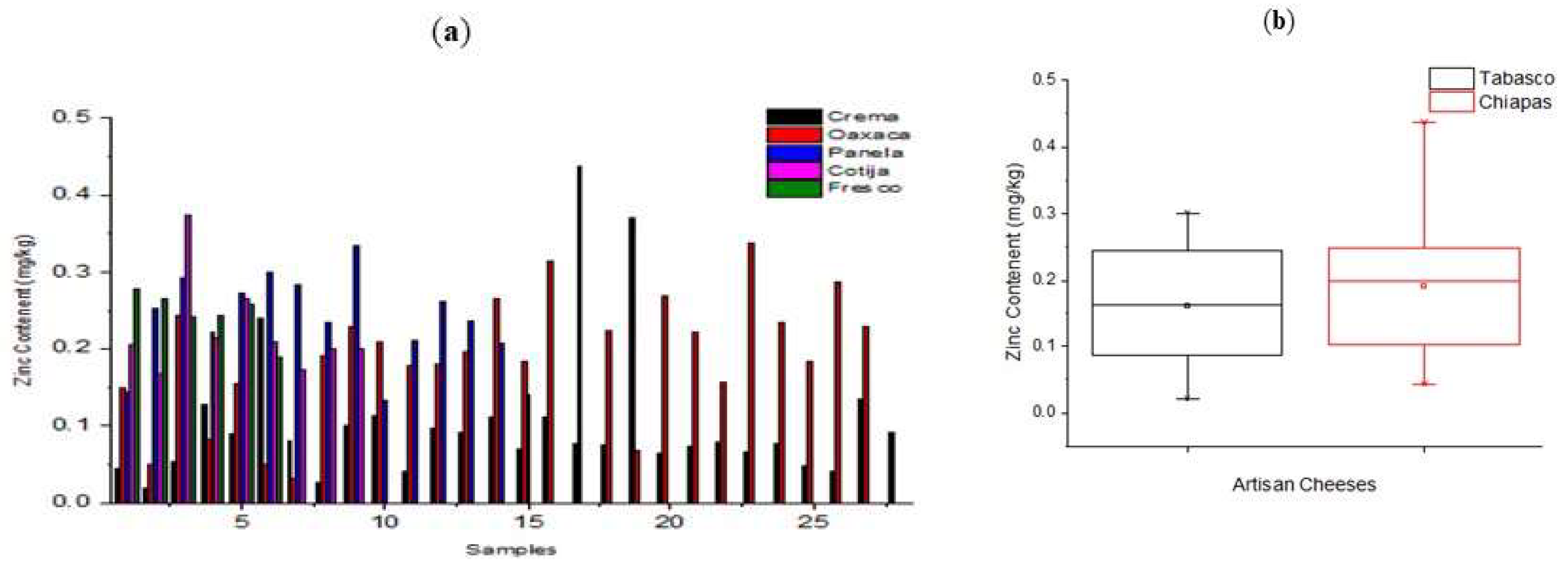
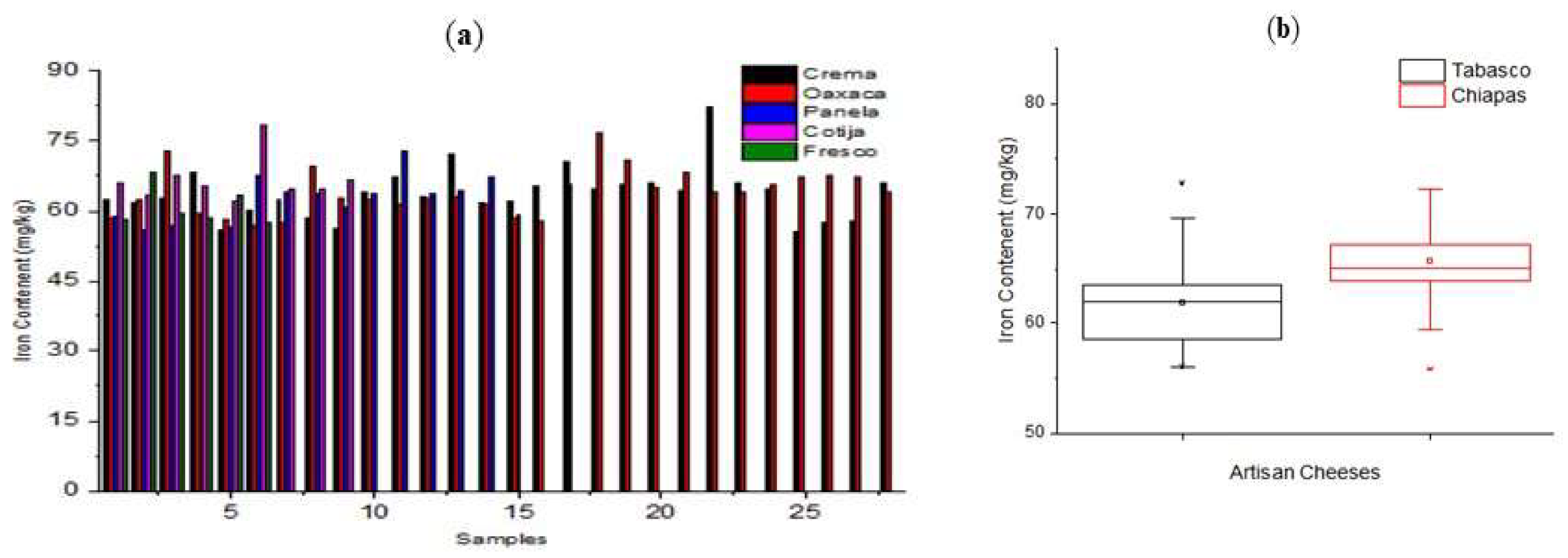
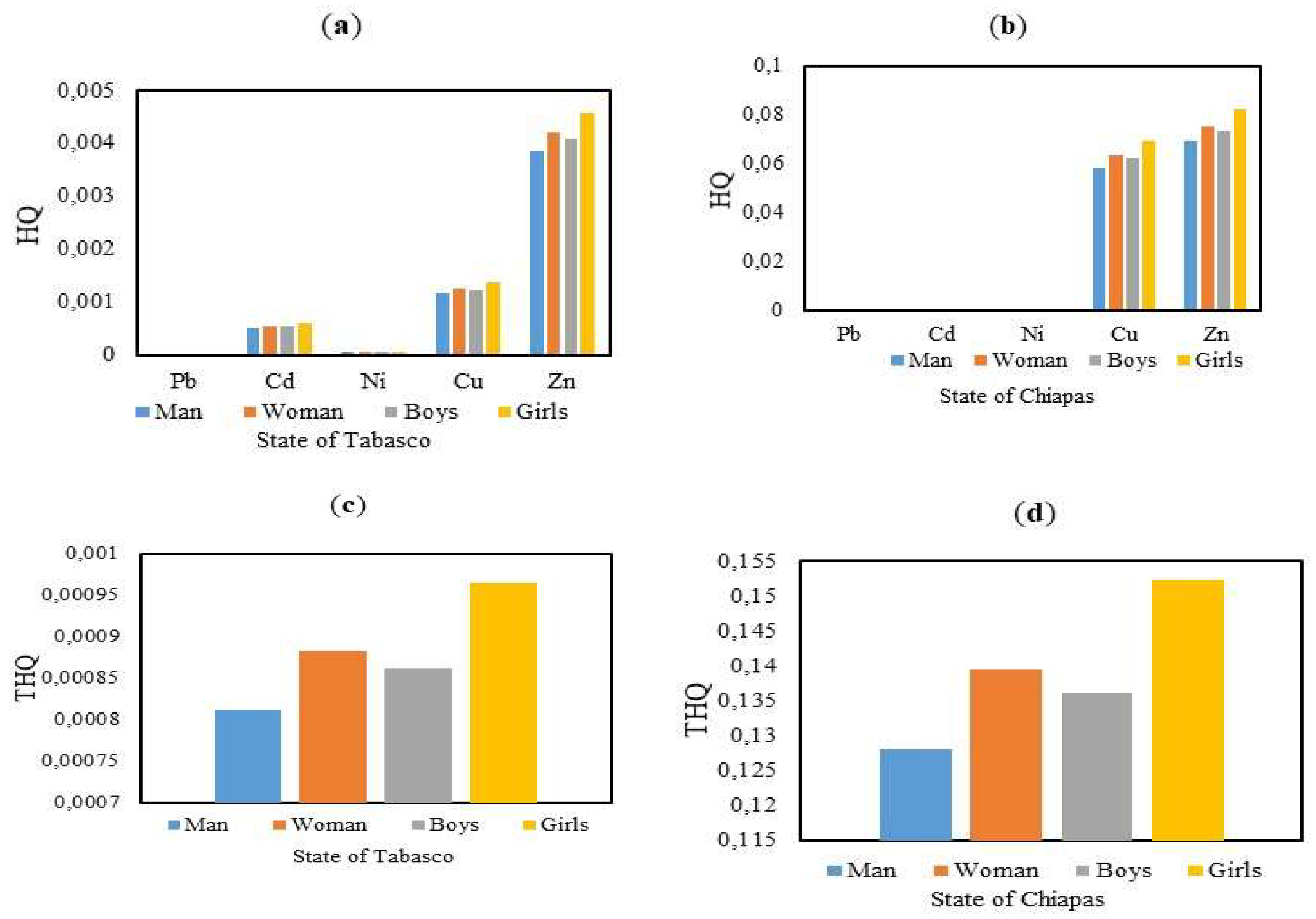
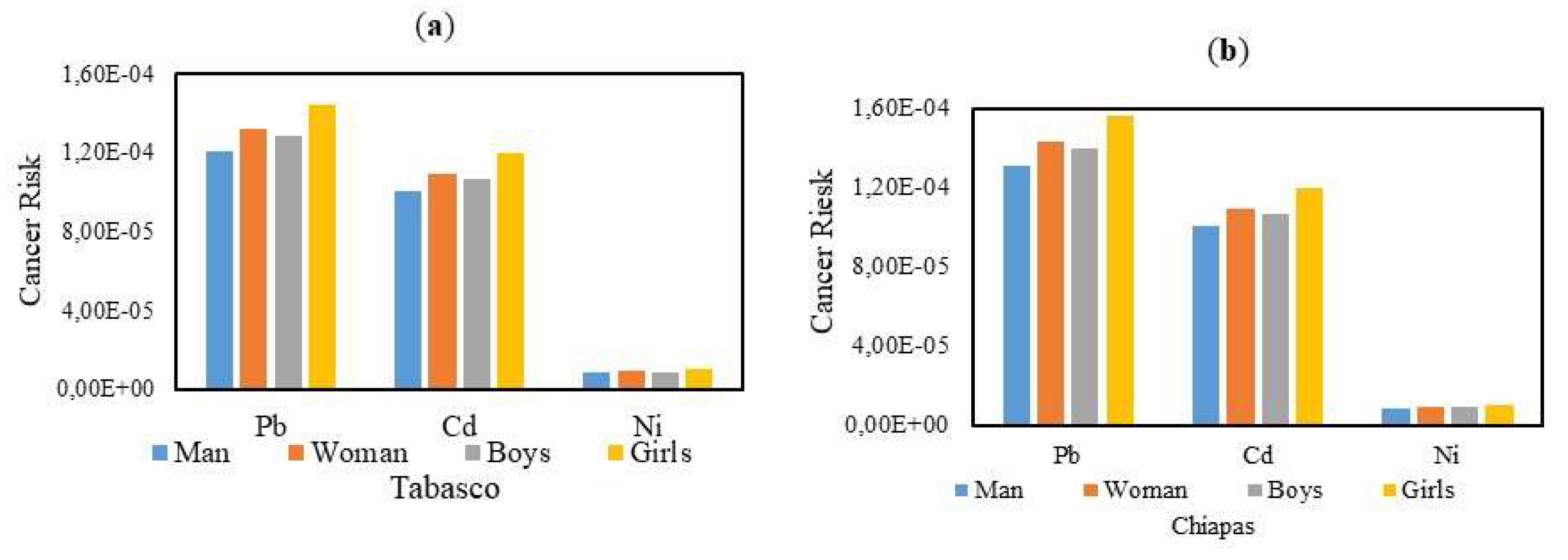
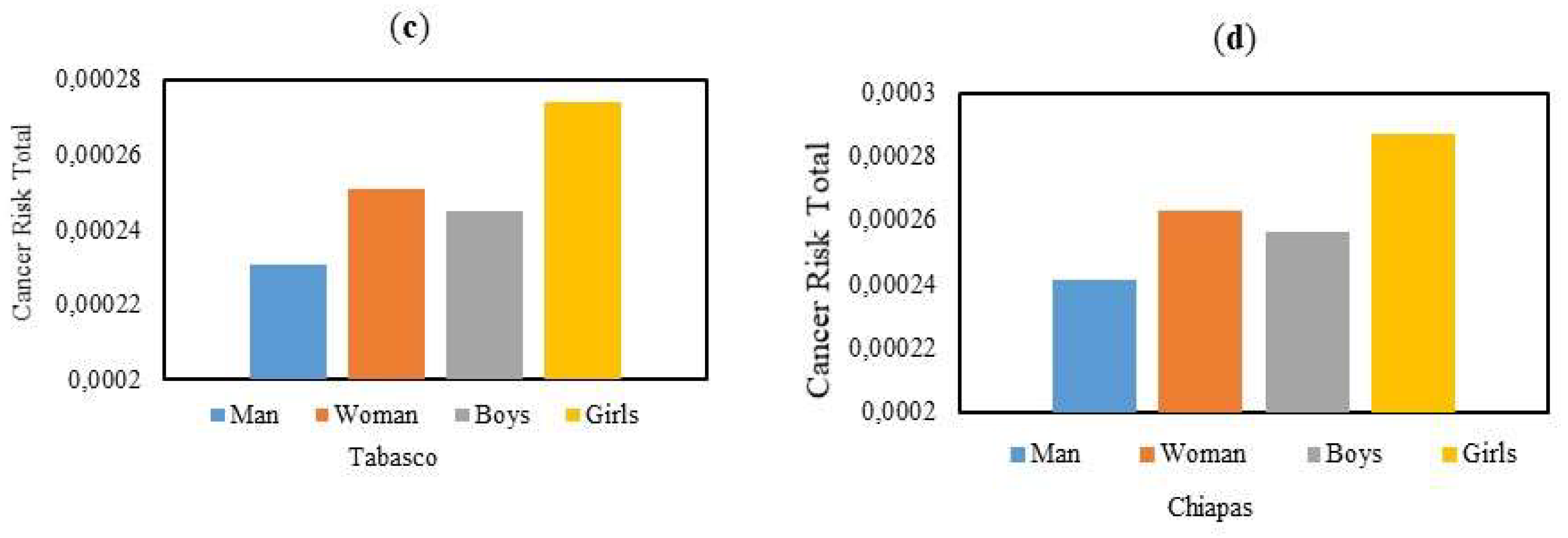
| Heavy metal | RfD (mg kg-1)* | Sf (mg kg-1 día-1)* |
|---|---|---|
| Cu* | 0.037 | - |
| Ni* | 0.02 | 0.1 |
| Pb** | 0.036 | 0.0085 |
| Cd** | 0.001 | 0.005 |
| Zn* | 0.3 | - |
| *US-EPA (2017) ** Bermúdez et al. (2011). | ||
| cheese variety | Municipality | Pb | Cd | Ni | Cu | Zn | Fe |
|---|---|---|---|---|---|---|---|
| double cream | Tenosique | 0.0047 | 0.0027 | 0.0002 | 0.0305 | 0.0443 | 62.48 |
| double cream | Tenosique | 0.0040 | 0.0021 | 0.0054 | 0.0212 | 0.0204 | 61.79 |
| oaxaca | Tenosique | 0.0035 | 0.0000 | 0.0024 | 0.0354 | 0.1494 | 58.48 |
| oaxaca | Tenosique | 0.0047 | 0.0004 | 0.0048 | 0.0059 | 0.0496 | 62.41 |
| oaxaca | Tenosique | 0.0028 | 0.0001 | 0.0032 | 0.0437 | 0.2443 | 72.76 |
| oaxaca | Balancán | 0.0029 | 0.0015 | 0.0005 | 0.0098 | 0.0823 | 59.65 |
| cream or soup | Balancán | 0.0046 | 0.0031 | 0.0096 | 0.0219 | 0.0532 | 62.73 |
| double cream | Balancán | 0.0043 | 0.0019 | 0.0037 | 0.0269 | 0.1271 | 68.26 |
| double cream | Balancán | 0.0057 | 0.0037 | 0.0012 | 0.0129 | 0.0904 | 55.97 |
| cream or soup | Balancán | 0.0078 | 0.0049 | 0.0018 | 0.0304 | 0.2418 | 60.04 |
| fresh | Balancán | 0.0068 | 0.0037 | 0.0042 | 0.0078 | 0.2785 | 58.38 |
| oaxaca | Balancán | 0.0041 | 0.0001 | 0.0041 | 0.0069 | 0.1554 | 58.39 |
| cream or soup | Centro | 0.0092 | 0.0063 | 0.0078 | 0.0402 | 0.0808 | 62.39 |
| panela | Centro | 0.0043 | 0.0019 | 0.0004 | 0.0059 | 0.1436 | 58.82 |
| oaxaca | Centro | 0.0044 | 0.0031 | 0.0005 | 0.0083 | 0.0499 | 56.92 |
| oaxaca | Centro | 0.0036 | 0.0016 | 0.0011 | 0.0102 | 0.0317 | 57.67 |
| mozzarella | Huimanguillo | 0.0035 | 0.0026 | 0.0007 | 0.0112 | 0.1019 | 63.58 |
| provolone | Huimanguillo | 0.0048 | 0.0001 | 0.0015 | 0.0275 | 0.1653 | 58.52 |
| fresh | Huimanguillo | 0.0034 | 0.0002 | 0.0033 | 0.0081 | 0.2659 | 68.29 |
| panela | Huimanguillo | 0.0043 | 0.0075 | 0.0019 | 0.0117 | 0.2542 | 56.07 |
| panela | Huimanguillo | 0.0039 | 0.0013 | 0.0009 | 0.0154 | 0.2927 | 56.93 |
| fresh | Huimanguillo | 0.0005 | 0.0004 | 0.0022 | 0.0098 | 0.2435 | 59.46 |
| fresh | Huimanguillo | 0.0041 | 0.0002 | 0.0021 | 0.0108 | 0.2447 | 58.56 |
| panela | Huimanguillo | 0.0047 | 0.0021 | 0.0034 | 0.0346 | 0.2231 | 57.98 |
| double cream | Huimanguillo | 0.0004 | 0.0047 | 0.0048 | 0.0298 | 0.0271 | 58.72 |
| panela | Huimanguillo | 0.0044 | 0.0001 | 0.0038 | 0.0135 | 0.2738 | 56.61 |
| double cream | Huimanguillo | 0.0038 | 0.0027 | 0.0069 | 0.0356 | 0.1008 | 56.18 |
| panela | Huimanguillo | 0.0031 | 0.0011 | 0.0027 | 0.0093 | 0.3008 | 67.77 |
| oaxaca | Huimanguillo | 0.0043 | 0.0019 | 0.0042 | 0.0136 | 0.2645 | 69.53 |
| panela | Huimanguillo | 0.0039 | 0.0003 | 0.0056 | 0.0115 | 0.2842 | 64.21 |
| cream or soup | Huimanguillo | 0.0063 | 0.0027 | 0.0087 | 0.0219 | 0.1135 | 63.98 |
| double cream | Huimanguillo | 0.0039 | 0.0035 | 0.0092 | 0.0298 | 0.0413 | 67.28 |
| panela | Huimanguillo | 0.0042 | 0.0009 | 0.0052 | 0.0167 | 0.2348 | 63.61 |
| fresh | Huimanguillo | 0.0041 | 0.0006 | 0.0034 | 0.0101 | 0.2598 | 63.34 |
| oaxaca | Huimanguillo | 0.0037 | 0.0009 | 0.0023 | 0.0177 | 0.1902 | 62.79 |
| oaxaca | Huimanguillo | 0.0064 | 0.0000 | 0.0015 | 0.0198 | 0.2295 | 62.56 |
| cream or soup | Huimanguillo | 0.0044 | 0.0026 | 0.0092 | 0.0257 | 0.0961 | 63.03 |
| oaxaca | Huimanguillo | 0.0084 | 0.0007 | 0.0039 | 0.0271 | 0.2095 | 61.47 |
| oaxaca | Huimanguillo | 0.0051 | 0.0000 | 0.0049 | 0.0209 | 0.1774 | 62.78 |
| oaxaca | Huimanguillo | 0.0043 | 0.0014 | 0.0044 | 0.0189 | 0.1805 | 63.15 |
| double cream | Huimanguillo | 0.0052 | 0.0156 | 0.0132 | 0.0378 | 0.0912 | 72.08 |
| cream or soup | Huimanguillo | 0.0125 | 0.0039 | 0.0032 | 0.0279 | 0.1121 | 61.77 |
| oaxaca | Huimanguillo | 0.0049 | 0.0011 | 0.0029 | 0.0088 | 0.1962 | 61.63 |
| double cream | Huimanguillo | 0.0072 | 0.0084 | 0.0042 | 0.0355 | 0.0708 | 62.04 |
| average | 0.0047±0.002 | 0.0023±0.002 | 0.0039±0.004 | 0.0199 ±0.02 | 0.1611±0.18 | 61.84±4.23 | |
| maximum | 0.0125 | 0.0056 | 0.0132 | 0.0437 | 0.3008 | 72.76 | |
| minimum | 0.0004 | 0 | 0.0002 | 0.0059 | 0.0204 | 55.97 |
| cheese variety | Municipality | Pb | Cd | Ni | Cu | Zn | Fe |
|---|---|---|---|---|---|---|---|
| double cream | Solosuchiapa | 0.0029 | 0.0041 | 0.0063 | 0.0177 | 0.1114 | 65.34 |
| oaxaca | Solosuchiapa | 0.0081 | 0.0000 | 0.0019 | 0.0098 | 0.2669 | 58.52 |
| panela | Solosuchiapa | 0.0007 | 0.0003 | 0.0012 | 0.0072 | 0.3308 | 60.89 |
| cotija | Solosuchiapa | 0.0047 | 0.0051 | 0.0009 | 0.0113 | 0.2047 | 65.98 |
| panela | Solosuchiapa | 0.0078 | 0.0034 | 0.0017 | 0.0059 | 0.1325 | 63.75 |
| panela | Solosuchiapa | 0.0067 | 0.0013 | 0.0031 | 0.0154 | 0.2112 | 72.94 |
| cotija | Solosuchiapa | 0.0056 | 0.0043 | 0.0043 | 0.0337 | 0.1664 | 63.33 |
| cotija | Juárez | 0.0047 | 0.0038 | 0.0075 | 0.0283 | 0.3708 | 67.89 |
| cotija | Juárez | 0.0039 | 0.0037 | 0.0056 | 0.0235 | 0.2157 | 64.52 |
| cotija | Juárez | 0.0049 | 0.0062 | 0.0037 | 0.0319 | 0.2654 | 62.19 |
| cream or soup | Juárez | 0.0051 | 0.0055 | 0.0091 | 0.0288 | 0.0766 | 70.49 |
| oaxaca | Juárez | 0.0083 | 0.0009 | 0.0016 | 0.0112 | 0.1839 | 57.96 |
| double cream | Juárez | 0.0069 | 0.0077 | 0.0015 | 0.0267 | 0.0748 | 64.86 |
| double cream | Juárez | 0.0035 | 0.0044 | 0.0039 | 0.0329 | 0.3699 | 65.65 |
| oaxaca | Juárez | 0.0033 | 0.0017 | 0.0052 | 0.0107 | 0.3145 | 65.79 |
| oaxaca | Juárez | 0.0047 | 0.0033 | 0.0044 | 0.0198 | 0.4369 | 76.67 |
| oaxaca | Catazajá | 0.0041 | 0.0013 | 0.0038 | 0.0067 | 0.2254 | 70.74 |
| oaxaca | Catazajá | 0.0003 | 0.0021 | 0.0021 | 0.0138 | 0.0677 | 64.91 |
| oaxaca | Catazajá | 0.0031 | 0.0027 | 0.0029 | 0.0103 | 0.2691 | 68.37 |
| double cream | Catazajá | 0.0075 | 0.0033 | 0.0078 | 0.0303 | 0.0642 | 65.87 |
| cream or soup | Catazajá | 0.0069 | 0.0031 | 0.0067 | 0.0281 | 0.0742 | 64.39 |
| double cream | Catazajá | 0.0084 | 0.0037 | 0.0025 | 0.0259 | 0.0787 | 72.33 |
| oaxaca | Catazajá | 0.0041 | 0.0011 | 0.0030 | 0.0155 | 0.2228 | 64.15 |
| double cream | Catazajá | 0.0069 | 0.0029 | 0.0039 | 0.0281 | 0.0665 | 65.94 |
| double cream | Catazajá | 0.0053 | 0.0033 | 0.0046 | 0.0277 | 0.0776 | 64.68 |
| oaxaca | Catazajá | 0.0008 | 0.0046 | 0.0026 | 0.0117 | 0.1505 | 64.02 |
| cotija | Catazajá | 0.0088 | 0.0047 | 0.0079 | 0.0267 | 0.2081 | 72.09 |
| cotija | Catazajá | 0.0045 | 0.0032 | 0.0061 | 0.0198 | 0.1735 | 64.75 |
| cotija | Catazajá | 0.0081 | 0.0041 | 0.0044 | 0.0319 | 0.1996 | 65.82 |
| panela | Catazajá | 0.0005 | 0.0007 | 0.0025 | 0.0167 | 0.2697 | 63.81 |
| cotija | Catazajá | 0.0041 | 0.0046 | 0.0027 | 0.0337 | 0.1908 | 66.58 |
| panela | Catazajá | 0.0011 | 0.0002 | 0.0006 | 0.0219 | 0.2364 | 64.33 |
| panela | Catazajá | 0.0009 | 0.0001 | 0.0019 | 0.0201 | 0.2062 | 67.51 |
| double cream | Reforma | 0.0067 | 0.0049 | 0.0054 | 0.0354 | 0.0489 | 55.82 |
| panela | Reforma | 0.0022 | 0.0023 | 0.0009 | 0.0285 | 0.1395 | 59.86 |
| fresh | Reforma | 0.0067 | 0.0011 | 0.0003 | 0.0197 | 0.1879 | 67.26 |
| double cream | Reforma | 0.0089 | 0.0051 | 0.0058 | 0.0205 | 0.0421 | 57.61 |
| cream or soup | Reforma | 0.0056 | 0.0045 | 0.0041 | 0.0322 | 0.1341 | 58.04 |
| double cream | Reforma | 0.0073 | 0.0026 | 0.0036 | 0.0167 | 0.0912 | 65.87 |
| oaxaca | Reforma | 0.0062 | 0.0019 | 0.0005 | 0.0139 | 0.3378 | 65.83 |
| oaxaca | Reforma | 0.0033 | 0.0034 | 0.0022 | 0.0112 | 0.2359 | 97.41 |
| oaxaca | Reforma | 0.0056 | 0.0008 | 0.0019 | 0.0209 | 0.1832 | 67.61 |
| oaxaca | Reforma | 0.0063 | 0.0037 | 0.0035 | 0.0223 | 0.2877 | 57.62 |
| oaxaca | Reforma | 0.0034 | 0.0003 | 0.0007 | 0.0202 | 0.2301 | 64.13 |
| average | 0.0051 ±0.002 | 0.0023±0.002 | 0.0031±0.004 | 0.0202±0.022 | 0.194 ±0.21 | 65.76±6.61 | |
| maximum | 0.0089 | 0.0077 | 0.0091 | 0.0354 | 0.437 | 97.41 | |
| minimum | 0.0003 | 0.0000 | 0.0003 | 0.0059 | 0.0421 | 55.82 |
Disclaimer/Publisher’s Note: The statements, opinions and data contained in all publications are solely those of the individual author(s) and contributor(s) and not of MDPI and/or the editor(s). MDPI and/or the editor(s) disclaim responsibility for any injury to people or property resulting from any ideas, methods, instructions or products referred to in the content. |
© 2023 by the authors. Licensee MDPI, Basel, Switzerland. This article is an open access article distributed under the terms and conditions of the Creative Commons Attribution (CC BY) license (http://creativecommons.org/licenses/by/4.0/).





